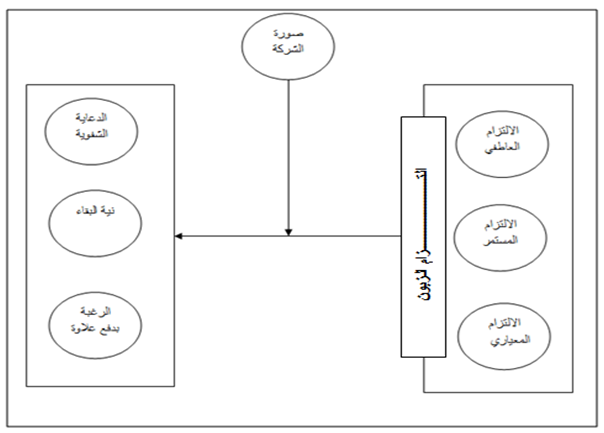The dynamics of the relationship between customer commitment and word-of-mouth advertising, the intention to stay, and the desire to pay a bonus through the interactive role of the company’s mental image - an analytical study of the opinions of a sample o
دراسة تحليلية لأراء عينة من زبائن شركة أسيا سيل
Keywords:
Affective commitment, calculative commitment, normative commitment, word of mouth, intention to stay, willingness to paycorporate imageAbstract
The present study aims to frame a customer-related model by investigation the impact of the customer's commitment to word of mouth, intention to stay, the willingness to pay, and impact the affective commitment to calculative commitment and normative commitment, and then to reinforce this relationship through the interactive role of the corporate image . A sample of 525 subscribers was selected from Asia Cell customers. Using the customer survey questionnaire, the data were analyzed by modeling the structural equation. An additional analysis was used to verify the interactive role of the image, which is the multi-regression regression analysis method. The results of the study indicate that affective commitment is the most important dimension that motivates customers to spread word of mouth, intention to stay, and willingness to pay. The impact of affective commitment on calculative commitment and normative commitment. The results showed that the company's image could strengthen those relationships. The study recommended improving the relationship of the company with customers who have a willingness to maintain the relationship with the company through the use of customer profitability analysis programs.
References
Abratt, R. (1989) "A New Approach to the Corporate Image Process", Journal ofMarketing Research, No. 2, 99-106.
Aindrila ,Biswas(2016) , A Study of Consumers’ Willingness to Pay for Green Products , Journal of Advanced Management Science , 4, (3),211-215.
Allen, N., and Meyer, J. P. (1990). The Measurement and Antecedents of Affective, Continuance, and Normative Commitment to the Organization. Journal of Occupational Psychology, 63 (1), 1-18.
Allen, N., Meyer, J. (1996). Affective, Continuance, and Normative Commitment to the Organization: An Examination of Construct Validity. Journal of Vocational Behavior, 49, 252-276.
Andreassen, T.W., & Lanseng, E. (1998). Customer loyalty and complex services: The impact of corporate image on quality, customer satisfaction and loyalty for customers with varying degrees of service expertise. Int. Journal of Service Industry Management, 9(1), 7–23.
Bansal, H., Irving, G., Taylor, S. (2004). A Three-Component Model of Customer Commitment to Service Providers. Journal of the Academy of Marketing Science, 32(3), 234-250.
Bansal, H., Taylor, S., James, Y. (2005). “Migrating” to New Service Provider: Toward a Unifying Framework of Consumers’ Switching Behaviors. Journal of the Academy of Marketing Science, 33(1), 96-115.
Bergman, M. (2006). The Relationship Between Affective and Normative Commitment: Review and Research Agenda. Journal of Organisational Behavior, 27, 645-663.
Brown, T. J., Dacin, P. A., Pratt, M. G., Whetten, D. A. (2006) "Identity, Intended Image, Construed Image, and Reputation: An Interdisciplinary Framework
Brown, T., Barry, T., Dacin, P., and Gunst, R. (2005). Spreading the word: Investigating Antecedents of Consumers’ Positive Word-of-Mouth Intentions and Behaviors in a Retailing Context. Journal of the Academy of Marketing Science, 33 (2), 123-138.
Dewitt, T., Nguyen, D., Marshall, R. (2008). Exploring Customer Loyalty Following Service Recovery: The Mediating Effects of trust and Emotions. Journal of Service Research, 10 (3), 269-281.
Evanschitzky, H., Gopalkrishnan, I., Plassmann, H., and Niessing, J., Meffert, H. (2016). The Relative Strength of Affective Commitment in Securing Loyalty in Service Relationships. Journal of Business Research, 59, 1206-1213.
Frequent Guest Programs). Cornell Hotel and Restaurant Administration Quarterly, 47 (2), 174-181.
Fullerton, G. (2003). When Does Commitment Lead to Loyalty?. Journal of Service
Fullerton, G. (2005). How Commitment Both Enables and Undermines Marketing Relationships. European Journal of Marketing, 39(11/12), 1372-1388.
Garbarino, E., and Johnson, S. M. (2016). The Different Role of Satisfaction, Trust, and Commitment in Customer Relationships. Journal of Marketing, 63 (April), 70-87.
Gellatly, I., Meyer, J., and Luchak, A. (2006). Combined effects of the Three Commitment Components on Focal and Discretionary Behaviors: A Test of Meyer and Herscovitch’s Propositions. Journal of Vocational Behaviors, 69 (February), 331-345.
Girish, Punj ,(2013)."The relationship between consumer characteristics and willingness to pay for general online content: Implications for content providers considering subscription-based business models". Marketing Letter,12,22.32-45.
Gustafsson, A., Johnson, M. D., and Roos, I. (2005). The Effects of Customer Satisfaction, Relationship Commitment Dimensions, and Triggers on Customer Retention. Journal of Marketing, 69 (October), 210- 218.
Hansen, H., Sadvik, K., and Selnes, F. (2003). Direct and Indirect Effects of Commitment to a Service Employee on the Intention to Stay. Journal of Service Research, 5 (4), 356- 368.
Harrison-Wallker, J. (2010). The Measurement of Word-of-Mouth Communication and An Investigation of Service Quality and Customer Commitment As Potential Antecedent. Journal of Service Research, 4(August), 60-75.
Herscovitch, L. and Meyer, J. (2002). Commitment to Organisational Change: Extension of Three-Component Model. Journal of Applied Psychology, 87 (3), 474-487.
Homburg, C., Koschate, N., and Hoyer, W. (2005). Do Satisfied Customers Really Pay More? A Study of the Relationship Between Customer Satisfaction and Willingness to Pay. Journal of Marketing, 69 (April), 84-96.
Hu, H., Kandampully, J., & Juwaheer, T.. (2009). Relationships and impacts of service quality, perceived value, customer satisfaction, and image: an empirical study. The Service Industries Journal, 29(2), 111-120.
Jaramillo, F., Mulki, J., Marshall, G. (2005). A Meta-Analysis of the Relationship between Organizational Commitment and Salesperson Job Performance: 25 Years of Research Journal of Business Research, 58, 705-714.
Johnson, M. D., Herrmann, A., and Huber, F. (2006). The Evolution of Loyalty Intentions. Journal of Marketing, 70 (April) 122-132.
Jones, M., Rynolds, K., Mothersbaugh, D., and Beatty, S. (2012). The Positive and Negative Effects of Switching Costs on Relational Outcomes. Journal of Service Research, 9(4), 335-355.
Klaus, Wertenbroch , (2002)Measuring Consumers’ Willingness to Pay at the Point of Purchase, Journal of Marketing Research ,4(4).87-99.
Lai, F., Griffin, M., & Babin, B.. (2009). How quality, value, image, and satisfaction create loyalty at a Chinese telecom. Journal of Business Research, 62(10), 980-997.
Mattila, A. (2001). The Impact of Relationship Type on Customer Loyalty in a Context of Service Failures. Journal of Service Research, 4 (2), 91-101.
Mattila, A. (2006). How Affective Commitment Boosts Guest Loyalty (and Promotes
Meyer, J., Srinivas, E., Lal, J., and Topolnytsky, L. (2007). Employee Commitment and Support for an Organizational Change: Test of the Three-Component Model in Two Cultures. Journal of Occupational and Organizational Psychology, 80, 185-211.
Meyer, J., Stanley, D., Herscovitch, L., and Topolnytsky, L. (2002). Affective, Continuance, and Normative Commitment to the Organization: A Meta-analysis of Antecedents, Correlates, and Consequences. Journal of Vocational Behavior, 61, 20-52.
Money, R. Bruce.) (2004Word-of-mouth Promotion and Switching Behavior in Japanese and American Business-to-business Service Clients. Journal of Business Research, , 57(3):297– 305.
Morgan, R. M. and Hunt, S. D. (1994). The Commitment-Trust Theory of Relationship Marketing. Journal of Marketing, 58 (July), 20-38.
Pritchard, M., Havitz, M., and Howard, D. (2015). Analyzing the Commitment-Loyalty Link in Service Contexts. Journal of the Academy of Marketing Science, 27(3), 333-348.
Research, 5 (4), 333-344.
Roos, I., (1999). Switching processes in customer relationships. Journal of Service Research, 2(1), 376-393.
Verhoef, P., Franses, P., and Hoekstra, J. (2002). The Effect of Relational Constructs on Customer Referrals and Number of Services Purchased From a Multiservice Provider: Does Age of Relationship Matter?. Journal of Academy of Marketing Science, 30(2), 202-211.
Wasti, S. (2005). Commitment Profiles: Combinations of Organizational Commitment Forms and Job Outcomes. Journal of Vocational Behaviour, 67, 290-308.

Downloads
Published
How to Cite
Issue
Section
License
Copyright (c) 2019 Economics and Administration College - Karbala University

This work is licensed under a Creative Commons Attribution-NonCommercial-NoDerivatives 4.0 International License.
Authors retain the copyright of their papers without restrictions.



